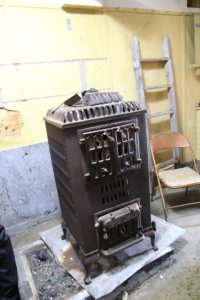At 07:30 a.m. we arrived in Dundas Harbour on Devon Island at 74° 26´ North, 86° 23´ West with an air temperature of -0.3°C and a sea temperature of 1°C. The sun is rising over the mountains and glaciers reach the sea.


Dundas Harbour is an abandoned settlement on the south coast of Devon Island in Nunavut Territory. Only a few ruins remain of the settlement along with one of the most northerly cemeteries in the world. The settlement was founded by the Hudson’s Bay Company and later the Royal Canadian Mounted Police, but the Inuit have lived here for much longer. In Inuit the settlement is known as Talluruti which translates as, ‘a woman’s chin with tattoos on it’. This may be a reference to tattoo wearing women reflecting or celebrating the complex geology of the landscape which we hope to see this afternoon. (Mission Impossible! If only we could have seen it.)


The archaeological remains that we explored during the mornings landing were of circular and rectangular tents which the Inuit used on summer hunting and fishing expeditions. The evidence of these activities was all around the headland that we crossed. When the Inuit erected their tents they used seal/walrus or timber to make a framework, usually a cone shape, cover this with sealskin and placed caribou fur around the perimeter of the interior and had the seal oil lamp (used for cooking and lighting) on the bare earth/rock in the centre. A small hole at the top of the cone allowed any smoke out. On the outside rocks and boulders were used to hold the sealskin and therefore the whole tent down on the ground. When the Inuit moved on they took their tent with them but the remains of their stay are still there. The circular ring of rocks and boulders and the bare ground inside with bones, sometimes the remains of tools, sometimes the remains of animals they could not eat. Near the circular tents along the shoreline are the remains of food caches. Any meat or fish that they could not eat in a meal was stored under these piles of rocks so that scavenging animals could not have a free meal.



Nearby was a rectangular Inuit site which clearly showed how flat and smooth granite was incorporated into the tent as flooring. Archaeologists think this is a relatively modern summer camp because of its rectangular shape, but also because of this flooring which may well have been used because it could be kept clean, whereas the older camps with bare earth could not. This was most likely a short summer camp because of the small number of walrus bones still visible.
We use the term earth here very loosely because there really isn’t any. The land is bare rock, weathered rock fragments and some sea eroded pebbles with small pockets of decaying grass, leaves, lichen and the tiniest weathered particles which form a soil for very small plants to grow. The Arctic Willow we saw is only millimetres in height. Lichens cover exposed rock and these take hundreds of years to grow to the extent we saw this morning.
When we left the ship temperatures had dropped to -1°C and it started to snow. In a very short time, the landscape we photographed upon arrival here. was white.
Over lunch the weather closed and the visibility was very poor. It was a day which the Inuit describe as one ‘when the sky fell’. By 2:30 p.m. the decision was made to go for landings as the ship could be seen from the shore. The dinghies do not have sophisticated radar systems so it is all by visual rules.
We landed at Dundas Harbour, which the base of the Hudson’s Bay Company formed in 1670 to gain the monopoly in the fur trade. It was incorporated by an English Royal Charter but based on a French idea from further south in Canada to trade with indigenous peoples. They trapped the furs and exchanged them for everyday items. Not only did HBC have the trade monopoly but actually owned the land over which its influence extended. At the time this made it the world’s biggest landowner. They established trading posts where the head trader was known as the factor. Some of the trading posts used this term in their name, e.g. in James Bay is Moose Factory. The biggest pelt traded was beaver fur. These furs were made into hats which became very fashionable and a popular item on the HBC’s list. To assist the native peoples who did not use money the HBC made tokens known as ‘Made Beaver’ tokens. So many tokens could purchase an item such as metal kitchen utensils. The biggest seller was ‘point blankets’. Made in England these woollen blankets had stripes, or points on them. So when ordering the number of points was used to indicate its size. Eight points was the same as a blanket for today’s king size bed. Little remains of the HBC post and only three buildings from the Mounted Police base which was last used in the 1990s before Nunavut was established.








The Mounted Police patrolled Devon Island because it is at the eastern extremities of the country even though it is the world’s largest uninhabited island.




As we complete this part of the blog we can see Dundas Harbour under an inch of snow but all put down in such a quiet manner.
In 2018 HBC employs 70,000 people and through its ’North’ Supermarkets has an annual sale of 500 million Canadian dollars.













